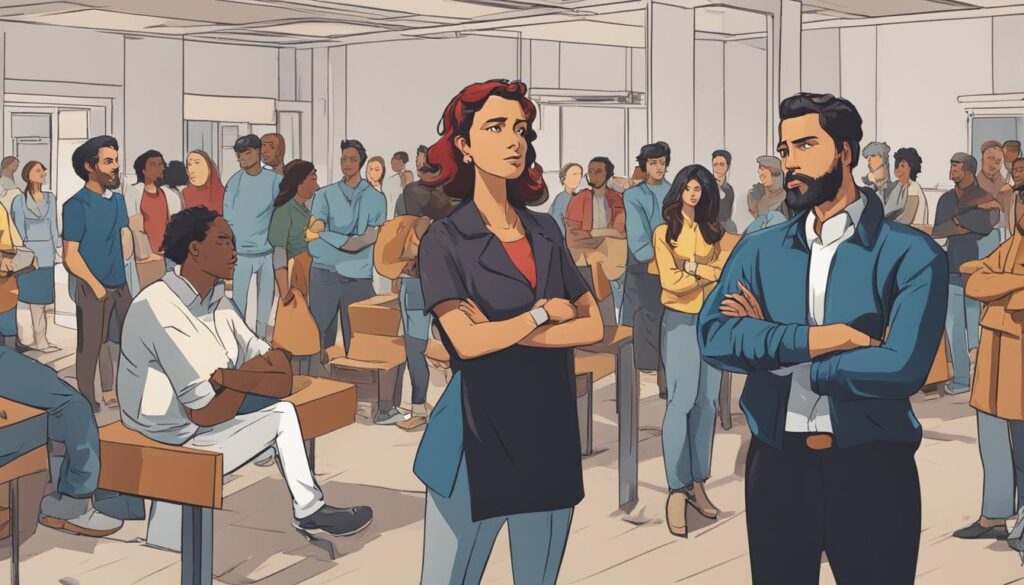In our daily lives, there are moments when we yearn for solitude and cherish our personal space. From navigating intrusive coworkers to dealing with persistent salespeople, asserting our need for independence and setting clear boundaries is a valuable skill. In this article, I will explore professional ways to say ‘leave me alone’ that allow us to maintain our autonomy and foster respectful relationships. Let’s discover the polite ways to ask for space and techniques for asserting our personal boundaries.
As we delve into this topic, we will discuss strategies for effectively communicating our desire for alone time, maintaining professionalism when seeking personal space, and handling situations where diplomacy becomes paramount. To navigate these waters gracefully, it is important to convey our message through empathy, gratitude, and understanding. By approaching these conversations with a tactful mindset, we can preserve our relationships while safeguarding our need for solitude.
Polite and Direct Approaches
When it comes to politely asking someone to go away, I believe in being clear and concise. There’s no need to beat around the bush or use ambiguous language. Instead, getting straight to the point while maintaining a polite demeanor is key. For example, you could say, “I appreciate your presence, but I’m currently occupied with an urgent matter. If you don’t mind, I would appreciate some privacy to focus on this task.” By expressing your need for personal space in a straightforward manner, you can effectively communicate your desire for solitude.
Creating boundaries and asserting our need for alone time is important for our mental well-being. By using polite and direct approaches, we can navigate these situations with grace and maintain harmonious relationships.
Expressing Gratitude and Setting Boundaries
In the art of politely asking someone to leave us alone, it is crucial to strike a delicate balance between gratitude and setting personal boundaries. Acknowledging the other person’s presence and showing appreciation for their time can go a long way in maintaining a respectful interaction, while also affirming our need for privacy and space.
Instead of resorting to rude or dismissive remarks like, “I really need some time alone now. Can you, like, leave?” we can choose a more considerate approach. By expressing gratefulness and politely requesting privacy, we not only uphold respect for the other person but also assert our own need for solitude.
“Thank you for stopping by. I have a pressing deadline that requires my undivided attention. If you could please excuse me for a while, I would be grateful.”
By expressing our gratitude for their presence and acknowledging their time, we create an atmosphere of appreciation. Simultaneously, we kindly communicate our necessity for uninterrupted focus and solitude, setting clear boundaries without compromising politeness.
| Expressing Gratitude and Setting Boundaries | |||
|---|---|---|---|
| Benefits: | 1. Maintains respect and appreciation | 2. Asserts personal need for solitude | 3. Sets clear boundaries politely |
| Approach: | 1. Express gratitude for their time | 2. Politely state the need for privacy | 3. Emphasize the pressing nature of the task |
| Example: | “Thank you for stopping by. I have a pressing deadline that requires my undivided attention. If you could please excuse me for a while, I would be grateful.” | ||
By adopting this approach, we demonstrate our respect for the other person while asserting our need for privacy. It allows for a harmonious interaction and fosters a sense of understanding between both parties involved.
Offering a Reason and Alternative
I apologize for the inconvenience, but I have an upcoming meeting, and I need to prepare for it. If you don’t mind, I’d appreciate some uninterrupted time to get ready.
Sometimes, it’s helpful to offer a brief explanation when asking for space. By providing a reason, you help others understand your situation and demonstrate that your request is legitimate. Whether you have an important task to complete or need time to recharge, explaining the need for space can enhance mutual understanding and respect.
Additionally, if appropriate, you can suggest an alternative time or place to meet, showing your willingness to engage with the person at a more convenient moment. This gesture not only acknowledges their presence but also establishes a foundation for future interactions. By offering an alternative, you maintain a polite and accommodating approach, even when requesting distance.
“I apologize for the inconvenience, but I have an upcoming meeting, and I need to prepare for it. If you don’t mind, I’d appreciate some uninterrupted time to get ready.”
Remember, providing a reason and offering an alternative can effectively communicate your need for space while keeping the conversation polite and respectful. Next, let’s explore techniques for maintaining a polite tone and body language when asking someone to leave you alone.
| Offering a Reason and Alternative | Benefits |
|---|---|
| Provides understanding | Enhances mutual respect |
| Establishes a foundation for future interactions | Demonstrates accommodation and flexibility |
Maintaining Polite Tone and Body Language
When requesting someone to give you space, it is essential to maintain a polite tone and convey respectful body language. Engaging in appropriate behavior and communication can help you express your desire for solitude without appearing dismissive or rude.
The way you present yourself physically plays a significant role in conveying your message effectively. Smile genuinely to create a warm and welcoming environment. Maintain eye contact to show that you are engaged in the conversation. Speaking with a composed and friendly tone can help to foster understanding and empathy.
“In every man’s heart, there is a secret nerve that answers to the vibrations of beauty.” – Christopher Morley
Crossing your arms, rolling your eyes, or speaking curtly can send a negative signal and hinder effective communication. Instead, keep your body language open and receptive. Avoid crossing your arms, as it can create a barrier between you and the other person. Opt for open gestures that encourage conversation and understanding.
Polite Body Language Tips:
-
Face the person directly, with your shoulders squared. This stance demonstrates openness and attentiveness.
-
Maintain an appropriate physical distance to respect personal boundaries and avoid invading someone’s space.
-
Use hand gestures that accompany your words and enhance understanding. However, avoid aggressive or intense gestures that may be misinterpreted.
Remember, maintaining both a polite tone and body language ensures that your desire for solitude is effectively communicated while preserving respectful and professional relationships.
| Polite Tone and Body Language: | Benefits |
|---|---|
| Showcasing open body language, such as maintaining eye contact and smiling genuinely | Establishing a positive and welcoming atmosphere |
| Maintaining a composed and friendly tone | Fostering understanding and empathy |
| Avoiding dismissive or rude gestures and expressions | Promoting effective communication and respectful relationships |
Utilizing Non-Verbal Cues
When it comes to communicating the need for alone time, non-verbal cues can be just as effective as verbal communication. These subtle gestures and actions can convey our desire for solitude in a professional and respectful manner.
One way to utilize non-verbal cues is by maintaining a comfortable physical distance. By creating a bit of space between yourself and the other person, you are subtly indicating a need for personal boundaries without explicitly stating it.
Turning slightly away from the person can also send a clear message. This slight shift in body language communicates that you are disengaging from the conversation or interaction and would like some time to yourself.
“Maintaining a comfortable physical distance and turning slightly away from the person can effectively communicate the need for space.”
Another effective non-verbal cue is to engage in tasks that signal your busyness. Glancing at your watch, taking a step back, or positioning yourself towards your work area can all communicate that you have important tasks at hand and would appreciate some uninterrupted time to focus.
These non-verbal cues can be especially useful in situations where direct confrontation may not be appropriate or desired. By using body language to express your need for space, you can maintain a professional and respectful demeanor while effectively communicating your desire for alone time.
Non-Verbal Cues Checklist:
- Maintain a comfortable physical distance
- Turn slightly away from the person
- Engage in tasks that signal your busyness
Final Thoughts
Remember, non-verbal cues should be used in conjunction with verbal communication to ensure clarity. While these cues can effectively convey your need for alone time, it’s important to also use appropriate language to express your desires politely. By mastering both verbal and non-verbal communication, you can confidently assert your need for solitude while maintaining professionalism and respect.
Expressing Empathy and Understanding
When seeking personal space, it is vital to approach the conversation with empathy and understanding. Regardless of our own needs for solitude, we should acknowledge and respect the needs or concerns of others, even if we are unable to accommodate them immediately. By demonstrating compassion, we can maintain a positive rapport and show consideration for their perspective.
Instead of dismissing their concerns outright or showing indifference, I aim to express understanding while asserting my need for solitude. For example, I might say, “I understand that you have something important to discuss, but at the moment, I am deeply engrossed in this task. Could we arrange a time later to address it properly?” By showcasing empathy and offering an alternative solution, I can effectively communicate my desire for personal space while maintaining a diplomatic and understanding tone.
The Power of Empathy
“Empathy is a bridge that connects individuals and fosters understanding. It is through empathy that we can navigate our unique needs for solitude while preserving the dignity and feelings of those around us.” – Anonymous
Expressing empathy allows us to validate the concerns and emotions of others, even when our own need for personal space takes precedence. By showing understanding, we create an environment where open communication and mutual respect can thrive.
Redirecting Attention and Offering Support
In moments when you need solitude but still want to help the person approaching you, redirecting their attention to an alternative resource or point of contact can be a thoughtful solution. By doing so, you convey your genuine willingness to assist them while maintaining your personal boundaries, offering a win-win situation for both parties involved.
For instance, if someone approaches you for help and you’re currently occupied, you can kindly say, “I’m currently occupied, but my colleague at [Company Name] specializes in this area. They will be able to assist you promptly.” This redirection ensures that the person’s request is addressed while allowing you to focus on your tasks at hand.
This approach not only showcases your helpfulness, but it also demonstrates your commitment to delivering high-quality assistance. By offering an alternative solution, you redirect the person’s attention toward someone who can meet their needs more effectively in the present moment.
- Redirecting attention politely:
- Express willingness to help
- Suggest an alternative resource or contact
- Ensure the person’s needs are met
Remember, it’s essential to maintain your personal boundaries while still offering support. Redirecting attention in a polite and professional manner allows you to balance your own needs with those of others, creating a respectful and harmonious environment in your interactions.
Ending on a Positive Note
| Professional Ways to Say ‘Leave Me Alone’ |
|---|
|
“Thank you for understanding. I look forward to connecting with you soon when I can give you my full attention. Have a great day!” |
As we wrap up the conversation on professional ways to say ‘leave me alone,’ it is essential to emphasize the importance of ending on a positive note. By expressing gratitude and goodwill, we can maintain a respectful and professional atmosphere while asserting our need for space.
Remember, when politely asking someone to go away or requesting personal space, starting and ending the conversation with a pleasant tone sets the stage for continued harmony in our relationships. By leaving a lasting and positive impression, we can foster mutual respect and understanding.
So, the next time you find yourself needing some alone time or personal space, consider using the phrase, “Thank you for understanding. I look forward to connecting with you soon when I can give you my full attention. Have a great day!” This statement conveys appreciation, acknowledges the other person’s understanding, and expresses the desire to reconnect at a more appropriate time.
In conclusion, let us employ these professional ways to say ‘leave me alone’ to assert our personal boundaries while maintaining respect and professionalism. By using polite language, expressing gratitude, and ending on a positive note, we can navigate these situations with grace and dignity.
Strategies for Fostering Family Connectedness
Family connectedness plays a vital role in the well-being and mental health of young people. It provides a stable foundation for positive development and helps them navigate the challenges of adolescence. To foster family connectedness, I believe in embracing the art of presence. Being fully present in your teenagers’ lives means actively engaging with them, showing genuine interest, and creating a safe space for open communication. This requires dedicating quality time to each other, setting aside distractions, and cherishing the moments shared.
One of the most effective ways to strengthen family connections is by sharing in each other’s interests. Taking an interest in your teenager’s hobbies, passions, and activities not only solidifies your bond but also demonstrates your support and understanding. Whether it’s attending their soccer games, joining them in their favorite video game, or exploring a new hobby together, these shared experiences create memories and deepen your connection.
| Benefits of fostering family connectedness | Strategies for fostering family connectedness |
|---|---|
| 1. Improved emotional well-being | 1. Be present in your teenagers’ lives |
| 2. Enhanced communication skills | 2. Share in each other’s interests |
| 3. Strengthened family bonds | 3. Value your teenagers for who they are |
| 4. Increased resilience in teenagers | 4. Strike a balance between freedom and boundaries |
Another important aspect of fostering family connectedness is valuing your teenagers for who they are. Celebrate their unique qualities, talents, and achievements. Create an environment where they feel accepted and loved unconditionally. By fostering a sense of belonging within the family, you provide them with the foundation they need to develop a strong sense of self and navigate the challenges of adolescence.
Lastly, it’s crucial to find a balance between freedom and boundaries. Teenagers need space to explore their own identities and assert their independence, but they also need structure and guidance. Establish clear expectations and boundaries while allowing them the freedom to make their own choices and learn from their experiences. Striking this delicate balance contributes to their growth and strengthens the family bond.
By actively engaging with your teenagers, sharing interests, valuing them for who they are, and establishing a balance between freedom and boundaries, you can foster a deep and lasting connection within your family. Remember, the foundation you build today will shape their future and create a sense of belonging that will support them throughout their lives.
Dealing with Difficult Situations and Mixed Messages
Parenting teenagers can be a delicate balancing act, especially when faced with mixed messages or challenging behaviors. As they navigate their path to independence, it’s essential to recognize that, deep down, most teenagers value family involvement and connection. By understanding their need for autonomy while providing guidance and support, we can successfully navigate these complex situations.
Showcasing a genuine interest in the lives of our teenagers is key. It allows us to establish a strong foundation of trust and opens the door for open communication. By actively listening and engaging with them, we create an environment that fosters connection. Whether it’s asking about their day, their interests, or their dreams, showing that we value them as individuals reinforces our commitment to their well-being.
Respecting their individuality is equally important. Each teenager is unique, and it’s crucial to honor their differences. Encouraging their passions and supporting their interests helps them develop a sense of self and allows them to explore their own identities. By providing a safe space for expression, we nurture their growth and build a stronger bond.
“In the midst of difficult behaviors, remember that your teenager is still figuring things out. Maintain empathy and understanding, even when faced with frustration.”
In this process, it’s essential to establish clear boundaries while granting them the freedom to grow. Boundaries provide guidance and structure while giving teenagers the opportunity to make their own decisions within a safe framework. By setting realistic expectations and consistently enforcing boundaries, we create an environment that cultivates respect and responsibility.
Key Strategies for Maintaining Relationships:
- Show genuine interest and engage in open communication
- Respect and encourage their individuality
- Establish clear boundaries while granting freedom
By adopting these strategies, we can navigate the challenging behaviors and mixed messages that often arise during this phase of life, strengthening our relationship with our teenagers. Remember that it’s a journey, and there will be moments of frustration, but with patience, empathy, and understanding, we can maintain a positive and loving connection.
Hang in There and Seek Support
If you find yourself in a challenging work situation, managing difficult work situations can feel overwhelming. It’s important to remember that you are not alone in facing these challenges. Take a deep breath and hang in there.
While it may be tempting to confront your difficult boss or engage in confrontational behavior, seeking allies for support can be a more effective approach. Look for colleagues within your workplace who understand the situation and can provide a reality check. They can be a source of guidance, encouragement, and a sounding board for your concerns.
Additionally, actively job search to minimize the amount of time you need to continue working in that environment. By exploring opportunities elsewhere, you can regain a sense of control and take steps towards a more positive work situation.
Remember to prioritize your well-being throughout this process. Seek support from friends, family, or even professional networks who can provide additional insight and guidance. By building a support network and seeking allies, you can navigate difficult work situations more effectively and protect your mental, emotional, and professional well-being.
Source Links
- https://workwizardry.com/how-to-tell-someone-to-go-away-politely/
- https://www.news24.com/life/relationships/family/just-leave-me-alone-why-staying-connected-to-your-teenager-is-tricky-but-important-20230720
- https://www.askamanager.org/2016/06/can-i-request-that-i-not-be-alone-with-my-boss.html












